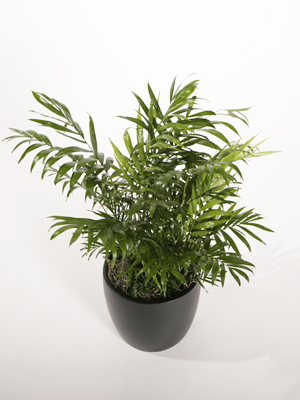Common Name: Bamboo palm
Light Needs
Low to medium light
Water Requirements
Water sparingly
Description:
Columnar, floor palm plant with upright clumps, C. erumpens and seifrizii may reach 14 feet; elegans only 6 feet. Stately, long-living palm that grows to 20 feet over time. The feathery triangular leaflets look like fishtails and are even a bit scaly.
Most commonly used varieties: Bamboo palm (C. erumpens); reed palm (C. seifrizii); parlor palm (C. elegans)
The Chamaedorea species palms are the workhorses of the interiorscape industry. C. elegans is low spreading with graceful arching fronds; it rarely grows taller than 6 feet. C. erumpens and C. seifrizii have tall, narrow profiles; they are useful in corners and other areas where space is limited. Chams are a hardy lot.
Low to medium light (50fc – 250fc). Generally, all species tolerate low humidity.
In low light (under 150fc), allow media to dry down one-half of the container, in medium light, one-third of the container. Pour water evenly around entire container to reach the extensive root system of the Chamaedorea species. These plants are famous for forming air pockets in the soil. Punch down the soil and fill in with fresh soil at least once per year. Leaf tips on older foliage turn black. Underwatering symptoms show up as older fronds turning yellow, then crispy brown, and dropping off. In addition, the new growth is pale with brown tips and the canes lean out of the container.
However, signs of overwatering can be yellow/browned frond tips that appear wet looking, perhaps ringed with yellow. Brown or gray new growth and of course root and stem rot are also signs of chronic overwatering. A palm cane that starts to flop over is a stem with a dying root system caused by too much water and not enough light.
Chamaedorea species are easily stressed by improper watering and soluble salt buildup. The foliage is sensitive and will develop spots or necrotic areas from improperly applied chemicals and fertilizers. Keep these palms healthy by keeping the foliage clean and pest free, the roots correctly watered and the nutrients in the growing media properly balanced. Refoliate thin plants by cutting canes down one- fourth inch above soil line one at a time. This will encourage the plant to sprout new growth from the base. Then, add soil to fill in the air pockets.
These palms will benefit from cleaning. Keep them healthy and clean by washing or wiping the fronds using mild castile soap and water. Don’t use leaf shine for all palms are very sensitive to chemicals. Besides, palms aren’t supposed to be shiny; a dull finish is a natural look for a palm. To remove dust, try using diaper wipes, white gloves or tube socks for a quick wipe down. If these come away with a yellowish tint, spider mites are present on the plant.
They do need to be fertilized at least twice per year if in good light and repotted (or at least some fresh soil added every couple of years to keep the roots from using up every bit of soil and then drying out.
Spider mites, thrips, mealybug, scale, soluble salts damage, stem and root rot (improper watering) and leaf spot.




